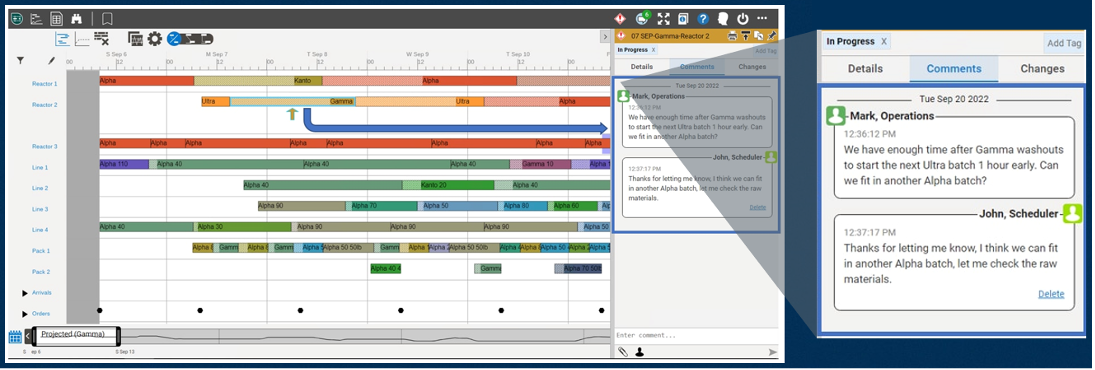Implementing new software solutions on a business level provides great opportunities to streamline the company and realize benefits like improved profitability, throughput and production agility. In order to maximize this value, business process changes need to be implemented as well. One way to help accelerate the adoption of new behaviors and software capabilities is to adopt the new solution in “stages,” where new software users are asked to make small changes at each stage, gradually building up to a significantly altered way of doing things leading to agile manufacturing.
Due to its intuitive interface and flexibility, Aspen Schedule Explorer™ (ASE) is ideally suited for this style of adoption and AspenTech has developed a systematic approach to help our customers. ASE is a web-based platform where users can view the most current production schedule version and collaborate with others by adding comments and tags (meta-data) directly on the scheduled activities. Currently, there are ASE customers at each stage of adoption and they are realizing benefits at every step along the way.

Figure 1: Aspen Schedule Explorer™ enables schedule visibility from operators to plant leaders.
Stage 1: A Self-Serve Kiosk for Schedule Visibility
There are numerous people within an organization who need to be continuously updated on the production schedule, including operators, production team leads, maintenance, quality control, raw materials procurement and plant management, to name a few. At this first stage in the adoption process, the goal is to make the schedule available to all these people who need it to do their jobs. The scheduler regularly publishes the most recent version of the schedule to ASE. People look to see the upcoming schedule and look at production details such as start and end times, quantities, bill of materials and order numbers.
At this stage, ASE provides several benefits over other methods of sharing the schedule (such as email or distributing paper copies). In ASE, users can always be sure they are looking at the most recent version of the schedule, they can view the schedule in either a Gantt or tabular format and they have access to all of the scheduled activity details in an easy-to-navigate interface.
Stage 2: An Emerging Digital Collaboration Community
As adoption progresses, there is an emerging community of people who are starting to use ASE as a communication platform. In ASE, these conversations are tied directly to their associated activities on the schedule. The team can easily see which comments are relevant to which activities, reducing the odds of misunderstandings that lead to costly mistakes. Additionally, these conversations remain on the activities after production has been completed and the schedule has been archived, making it easier to investigate issues that may come to light after production is finished.
At this stage, it’s mostly going to be schedulers and operations/unit team leaders who are pushing out comments to their team members. This helps provide visibility into issues, reminds team members of important things they need to consider before, during and after a certain production activity and provides situational awareness into things that matter at the site. Most operators at this stage are still just using it to consume information, similar to how they would use ASE in the first stage. However, because this information now includes additional comments, instructions and requests from the schedulers and team leaders, operators have better insight into things such as specific instructions for a certain batch of product that may not be easily captured in the standard activity details.
Stage 3: Digital Collaboration Harnessed for Smart Manufacturing Purposes
At this stage, ASE has been adopted by all manufacturing and supply chain stakeholders. The expectation is that everyone is communicating about the schedule and business processes have been put in place to establish best practices and guidelines to realize maximum benefit for the site or company. For example, some of our customers who are at this level of adoption are communicating, in near real-time, information about the current production status of all their resources, reaching a new level of agile manufacturing. This type of capability can be automated using AspenTech Inmation™ to notify key stakeholders of all key supply chain and operational events influencing production, for example, every time a batch starts production or is completed, tags (meta-data) are added to the activity (by a person or by another system automatically) and relevant comments are added. If there are any noteworthy conditions during production, such as temperature fluctuations or non-standard materials used, they are documented in the ASE comments. Quality testing results are also added in ASE. This production visibility ensures that schedulers and plant management always have the most up to date information on how the schedule is progressing and can quickly respond to issues that may arise or provide feedback to operations personnel. Some of our customers at this stage have reported astonishing improvements in their metrics (increasing site production throughput by 20%!) since adopting ASE, in part due to becoming agile in responding to the inevitable daily supply and demand disruptions.
Additionally, having all that information centralized provides great benefit from a root cause analysis perspective. We know from speaking to manufacturers that they often keep an archive of old schedules to go back and reference if, for example, a customer reports an issue with the product. Looking at these old schedules can help schedulers investigate if a transition/setup/cleanout from one batch to the next or similar issue may be the root cause of the customer-reported problem. But with ASE, not only is this archive digitally managed, all the comments and tags (meta-data) added to an activity remain with the historical schedules as well. When all supply chain and operations execution stakeholders communicate about the schedule, this makes those root cause investigations even quicker and easier than before. Not only can the users view historical schedule and production information, they also have the full context of all the comments and tags—information that would be spread across multiple systems if not for ASE.
Ease of Use = Quick Time to Value
Our customers have reported that ASE is well-suited for quick adoption, due to its web-based platform and intuitive interface. It provides value by simply letting users browse the information that is available there and that is where many of our customers start out. However, by creating well-defined business procedures, businesses can unlock massive benefits from this tool including agile manufacturing and supply chain resilience. Implementing best practices and ensuring adherence to these policies allows ASE to be much more than a read-only version of the schedule. It creates a collaborative hub that serves as a focal point for all schedule-related information, questions and conversations, which increases organizational agility, creates an archive of production information and improves customer service.
.png?h=250&w=975&la=en&hash=2873B6877063F71DFD0119E21E940D6A)




Leave A Comment